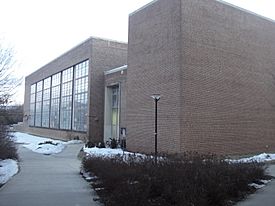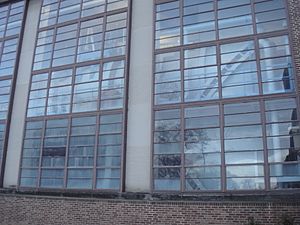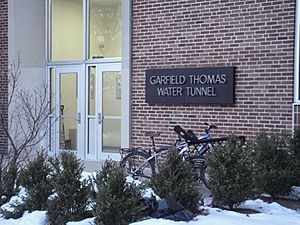Garfield Thomas Water Tunnel facts for kids
Quick facts for kids Garfield Thomas Water Tunnel |
|
|---|---|
 |
|
| General information | |
| Status | Complete |
| Type | Educational, R&D |
| Location | University Park, Pennsylvania |
| Address | North Atherton Street, University Park, PA, 16801 |
| Coordinates | 40°47′35″N 77°52′06″W / 40.793054°N 77.86822°W |
| Construction started | 1948 |
| Completed | October 7, 1949 |
| Opening | March, 1950 |
| Renovated | 1992 |
| Client | ARL, U.S. Navy |
| Owner | Penn State's Applied Research Laboratory |
The Garfield Thomas Water Tunnel is a super cool science lab at Penn State. It's like a giant swimming pool for testing how things move through water! The U.S. Navy uses it a lot to study things like submarines and torpedoes. Scientists also use it to test new ideas for Space Shuttle pumps, advanced ship propulsors (which push ships through water), and even artificial heart valves.
This amazing facility opened way back in 1949. For many years, it was the biggest circulating water tunnel in the whole world! It's so important that it's been named a historic landmark for mechanical engineering.
Contents
History of the Water Tunnel
After World War II, the U.S. military wanted to invest more in science and research at universities. At this time, a special lab that invented the first acoustic torpedo (a torpedo that finds its target using sound) moved to Penn State. This lab became the Ordnance Research Laboratory (ORL).
The Garfield Thomas Water Tunnel was built at Penn State to help the ORL with its torpedo research. Construction finished on October 7, 1949, and it started working six months later. Over the years, the tunnel's research expanded to include studies on how liquids flow, sound, waves, and even wind. In 1992, the entire facility was updated and improved.
What the Water Tunnel Can Do
This facility has several different areas for experiments. It includes various types of water tunnels and other special labs.
Different Water Tunnels
The facility has four main water tunnels for different kinds of tests.
The Main Garfield Thomas Water Tunnel
The Garfield Thomas Water Tunnel is the biggest one. It's 100 feet long and 32 feet high, holding 100,000 gallons of water! A powerful 2,000-horsepower pump pushes the water, making it flow as fast as 40 miles per hour. This tunnel can also change the water pressure, from very high to very low.
Scientists use many tools here, like special cameras and sensors. These tools help them measure how much force water puts on objects, how fast things spin, and even how much noise they make underwater.
Smaller Water Tunnels for Testing
The facility also has two smaller water tunnels. One is 12 inches wide, and the other is 6 inches wide. Both are closed-circuit, meaning the water flows in a loop. The 12-inch tunnel has a 150-horsepower pump that can make water move up to 54 miles per hour! The 6-inch tunnel uses a 25-horsepower pump and can reach speeds of 47 miles per hour.
These smaller tunnels are also equipped with lasers and special sensors to measure pressure and sound.
Ultra-High Speed Cavitation Tunnel
There's also a very fast 1.5-inch cavitation tunnel. Cavitation happens when water pressure drops so low that tiny bubbles form and then burst, which can damage things. This tunnel can make water go incredibly fast, up to 187 miles per hour! It's made of strong stainless steel and can handle very high pressures and a wide range of temperatures.
Other Research Facilities
Besides the water tunnels, the facility has other cool labs. There are wind tunnels to study how air moves, and glycerin tunnels to study how thick liquids flow. There's even a special soundproof room called an anechoic chamber for sound experiments.
One lab uses a 12-inch pipe to study how thick glycerin flows. Another lab has a powerful fan that can create wind speeds of over 81 miles per hour. This is used to research how fan blades work. There's also a large 2.75-meter wide closed-circuit tunnel used to study how fluids move very close to a wall.
See also
- Pennsylvania State University Applied Research Laboratory
- Water tunnel (hydrodynamic)
- Ship model basin
- Pennsylvania State University
- List of historic mechanical engineering landmarks



